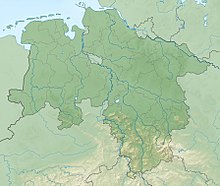Günnemoor
Coordinates: 53 ° 16 ′ 46.9 " N , 8 ° 54 ′ 39.7" E
The Günnemoor is a raised bog in the Osterholz district in northern Lower Saxony . Since the late 1980s there have been conflicts over industrial peat extraction in the bog.
The Günnemoor is located between the villages of Teufelsmoor , Bornreihe and Verlüßmoor, just under 10 km north of Worpswede . The core of the Teufelsmoorkomplex to the west of the Hamme was in Günnemoor . The age of the Günnemoor is estimated to be around 5000 years. Its peat thickness was over 9.50 m at the beginning of the 20th century. The Günnemoor includes moor heaths , dragonwort and gagel stocks as well as - as secondary biotopes - birch forests, pipe grass meadows and now rewetted peat extraction areas with peat moss and round-leaved sundew . The moor serves as a breeding area and resting place for the crane . The adder is also found there. The Günnemoor used to be a breeding area for black grouse and golden plover ; but these birds character of raised bogs disappeared over time after the Moor industry from the beginning of 1920 abgetorft was.
status
Thanks to the extensive rewetting, the crane was able to be resettled as a migratory bird. The Günnemoor is a resting area for large migrations of cranes in autumn and spring. A hiking trail leads along the western edge of the peat extraction area. This path is only accessible from April to September and is therefore closed during the migration period for cranes and wild geese. The financing of a planned observation tower has not yet been secured due to other projects.
The moor is part of the “ Teufelsmoor ” nature reserve, which was designated in April 2017 .
history
After peat farming since the peat colonization under Findorff , peat was mined industrially from 1920 onwards by the Teufelsmoor district farm using the sod cutting process. After 1980, more peat was mined in the Günnemoor area by the TURBA peat industry with large construction machines and deep drainage, now using the milled peat method.
In 2003 the TURBA applied for an extension to peat removal. A further 250 hectares of bog that border on the previous mining area would then be affected. In the autumn of 2010, a 20 hectare large, previous blueberry plantation and parcels in the immediate vicinity of the renatured mining areas were designated as a priority area for peat extraction in the draft of the state spatial planning program. In addition to the nature conservation associations, several regional authorities, such as the city of Osterholz-Scharmbeck and the district of Osterholz, turned against this. In 2011, the then Environment Minister of Lower Saxony, Hans-Heinrich Sander , spoke out against further peat extraction in the area of the Teufelsmoors.
After violating the conditions of the permit and protests by nature conservation associations, a contract was concluded in 1998 between the Osterholz district and the mining company on the partial rewetting and termination of the mining by 2013.
Trivia
The writer Manfred Hausmann created a literary monument on the moor with the short poem “Im Günnemoor”.
Web links
- Peat extraction in Günnemoor , Biological Station Osterholz e. V. (PDF file, 80 kB)
Individual evidence
- ↑ Weser-Kurier of October 16, 2013.
- ^ Lutz Rode: Environment Minister is against further peat extraction in Günnemoor , Weser-Kurier, January 13, 2011.
- ↑ Manfred Hausmann: In the Günnemoor. In: "Alte Musik", Berlin: Fischer 1941.

